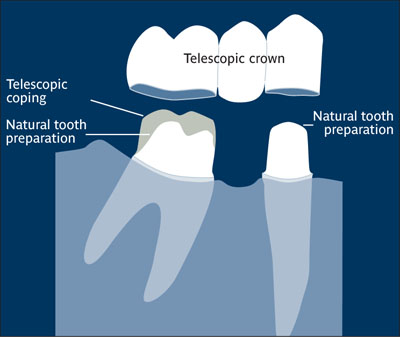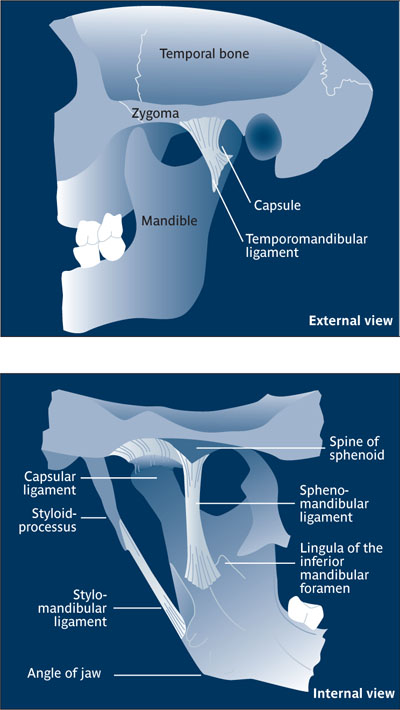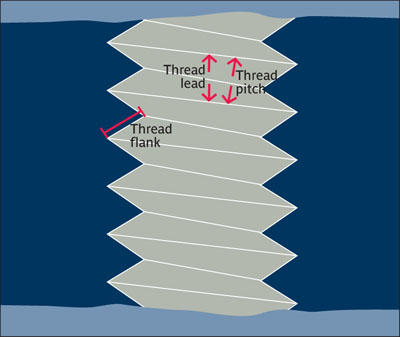T
Tannerella forsythensis Fusiform, fastidious, anaerobic gram-negative member of the Cytophaga-Bacteroides family implicated in periodontal and peri-implant diseases. T forsythensis, Porphyromonas gingivalis, and Treponema denticola form a red complex of species associated with aggressive periodontal infections. This organism, previously described as Bacteroides forsythus, was subsequently reclassified to T forsythensis based upon its phylogenetic position.
Tantalum (Ta) Malleable metal used in the past to fabricate plates, wires, and discs for implantation; atomic number 73 and atomic weight 180.948.
Tape See: Articulating tape.
Tapered implant Shape of an implant body when viewed in profile, lengthwise. A tapered implant usually narrows apically
Tapered impression coping Impression coping designed to narrow toward the occlusal surface; varies in length.1

Tapered impression coping.
Tapping Final bone preparation of the screw thread configuration prior to implant placement.
Tarter See: Calculus.
T cell Thymus-dependent lymphocytes that are spherical cells of the lymphoid series and among the principal cells involved in the cell-mediated immune response.
TCP Abbreviation for Tricalcium phosphate.
Team approach Multidisciplinary combination and collaboration of care and/or therapy providers in the restorative management of a patient whose treatment involves dental implants.2-4
Teflon compression ring Prosthetic component made of polyoxymethylene intended to provide resilience between the implant and the prosthesis. This ring is placed between the transmucosal element and the prosthesis.5 See also: Intramobile connector.
Telescopic coping Concept in fixed prosthodontics in which an intermediate coping can be designed to compensate for a malaligned retainer. Stacked crowns are fabricated with the contours to fit within the confines defined by a single restoration, without causing clinical or prosthetic complications associated with overcontoured crowns. This technique is used in overdenture therapy in which natural teeth are retained and restored using a crown (ie, telescopic coping) designed with minimal thickness to serve as a patrix component; the matrix component (ie, telescopic crown) is then incorporated into the prosthesis.6,7

Telescopic coping.
Telescopic coping attachment system Retentive mechanism that employs a frictional fit between the matrix and patrix components. External surface of the patrix mirrors the internal surface of the matrix and fits within the confines of the matrix for a frictional, passive fit.89 See also: Telescopic coping.
Template See: Surgical template.
Temporary abutment Implant component used for a limited period of time prior to fabrication of the definitive prosthesis.
Temporary cement See: Cement.
Temporary cylinder See: Temporary abutment.
Temporary healing cuff See: Healing abutment.
Temporary prosthesis See: Provisional prosthesis.
Temporomandibular articulation Ginglymoarthrodial-type articulating joint involved in the bilateral connection of mandibular condyles to the temporal bone. Anatomic structures comprising the joint are: the anterior part of the glenoid cavity of the temporal bone, its articular eminence, and the mandibular condyle; the ligaments supporting the joint are the temporomandibular, capsular, sphenomandibular, stylomandibular, and the articular disk or meniscus. The joint facilitates mandibular movements involving depression and elevation, as well as forward, backward, and lateral combinations.10,11

Temporomandibular articulation.
(Redrawn from Gray12 with permission.)
Temporomandibular joint Articulation between the mandibular condyles and glenoid fossa of the temporal bone is capable of translation and rotation movements. The disk is composed of dense fibrous connective tissue, while the posterior attachment is highly vascularized and innervated. The joint is surrounded by the capsular ligament, a fibrous capsule. See also: Temporomandibular articulation.
Tensile strain Elongation ÷ original length x 100%.
Tensile stress Force applied to an object that elongates or stretches.
Tension-free wound closure Wound closure that can be obtained without flap tension. Underlying periosteum may need to be released to provide coverage of an augmented site. See also: Releasing incision.
Tent pole procedure Operation in which the anterior part of an atrophic mandible is exposed by extraoral approach; periosteum and soft tissues are elevated to expose the superior aspect of the mandible. Dental implants are placed by tenting the soft tissue matrix to prevent graft resorption. Particulate autogenous bone chips are onlayed under the periosteum and around the implants.
Tenting screw Metal screw used in guided bone regeneration (GBR) procedures to support barrier membranes retaining space for new bone formation.13
Test, chi-square See: Chi-square test.
Tetracycline Group of wide-spectrum antibiotics seldom used in treatment of oral infections but may be used for rhinogenic infections. Some are natural (ie, isolated from certain species of Streptomyces) and others are produced semisynthetically. Tetracyclines and their analogues inhibit protein synthesis by their action on microbial ribosomes and have anti-matrix metalloproteinase (MMP) activity. All have similar toxic and pharmacologic properties, differing mainly in their absorption and suitability for various modes of administration. They are effective against a broad range of aerobic and anaerobic gram-positive and gram-negative bacteria, as well as rickettseae, chlamydiae, and mycoplasmas. Because of the binding to calcium, it is not advisable to use tetracyclines in the treatment of infections in children.
Tetracycline bone labeling Permanent labeling of osteoid (bone matrix) as it mineralizes in a two-phase process. With up to 80% of complete mineral uptake regulated by osteoblasts, the remaining 20% is regulated by osteocytes. The osteoid zone is separated from the mineralized part of the bone by a layer called the mineralization front. This layer is able to bind tetracycline, resulting in a permanent fluorescent line.
Textured surface See: Rough implant surface.
Texturing Application of texture; to roughen.
TGF Abbreviation for Transforming growth factor.
TGF-β Abbreviation for Transforming growth factor beta.
Thick flat periodontium See: Periodontal biotype, Thick.
Thin scalloped periodontium See: Periodontal biotype, Thin.
Thread Grooves cut into the walls of a cylinder making it a screw (positive) or a screw channel (negative). These structures guide the insertion and removal of a screw or bolt. Also, the act of inserting a screw or bolt into its receiving channel. Example: The next step is to thread the occlusal screw into the abutment.
Major diameter of t. Greatest thread diameter of a tapered screw. The diameter by which the screw is designated. Compare: Thread, Minor diameter.
Minor diameter of t. Smallest thread diameter of a tapered screw. Compare: Thread, Major diameter.
Thread flank Side of a thread between the crest of the thread and the depth of the thread. In most applications the thread angle between the flanks of a thread is 60 degrees. (See figure next page.)
Thread lead Distance between screw threads as measured in the direction of the long axis of the screw. Compare: Thread pitch.
Thread pitch Distance between threads, in millimeters, as measured perpendicularly to the thread axis. In American units, thread pitch is given in threads per inch. Compare: Thread lead.

Thread flank, thread lead, thread pitch.
Threaded implant Implant body design resembling a screw, including helical threading developed into the external surface of the implant. Term does not describe the connnection present between the anchorage component and the prosthetic component, which may or may not include an internal bore within the anchorage component. See also: Implant thread.
Three-dimensional guidance system for implant placement
Stay updated, free dental videos. Join our Telegram channel

VIDEdental - Online dental courses


